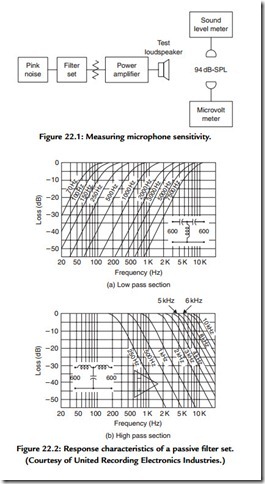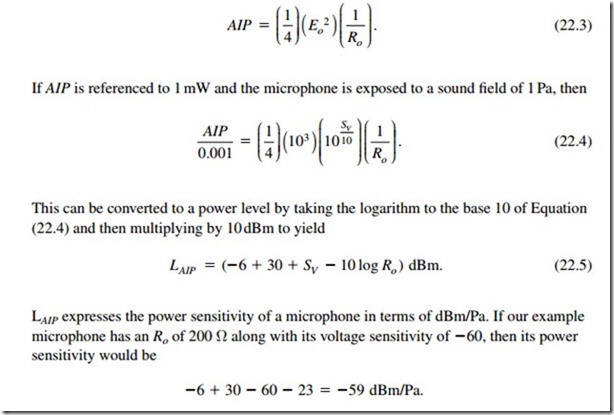Microphone Sensitivity
In order to determine the electrical input level to a sound system, we need to measure the electrical output generated by the system microphone when it is subjected to a known sound pressure (SP). In making such measurements an LP of 94 dB (1 Pa) is recommended as this value is well above the normally encountered ambient noise levels.
Everyone seriously interested in the field of professional sound should own or have easy access to a precision sound level meter (SLM). Among other uses, an SLM is required to measure ambient noise, to calibrate sources, and, on occasion, to serve as input for frequency response, reverberation time, signal delay, distortion, and acoustic gain measurements.
Setting up the microphone measurement system shown in Figure 22.1 requires a pink noise generator, a micro-voltmeter, a high-pass and low-pass filter set such as the one illustrated in Figure 22.2, a power amplifier, and a well-constructed test loudspeaker, in addition to the SLM.
Select a measuring point (about 5 to 6 ft) in front of the loudspeaker and place the SLM there. Adjust the system until the SLM reads an LP of 94 dB (a band of pink noise from 250 to 5000 Hz is excellent for this purpose). Now substitute the microphone to be tested for the SLM. Take the microphone open circuit voltage reading on the micro-voltmeter. The voltage sensitivity of the microphone can then be defined as
where SV is the voltage sensitivity expressed in decibels referenced to 1 V for a 1-Pa acoustic input to the microphone and Eo is the open circuit output of the microphone in volts.
where Eo is now the open circuit voltage output of the microphone for an arbitrary acoustic input of level LP.
For example, suppose a sample microphone is tested by the conditions of Figure 22.1 with the result that the open circuit voltage is found to be 0.001 V. The voltage sensitivity of this microphone as calculated from Equation (22.1) is then
 This result would be read as .60 dB referenced to 0 dB being 1 V per pascal (1 V/Pa).
This result would be read as .60 dB referenced to 0 dB being 1 V per pascal (1 V/Pa).
If this same microphone were exposed to an acoustic input level of 100 dB rather than the test value of 94 dB, then its open circuit output voltage from Equation (22.2) would become
Many current microphone preamplifiers have input impedances that are at least an order of magnitude or larger than the output impedances of commonly encountered microphones. In such instances, Equation (22.2) can be employed to determine the maximum voltage that a given microphone and sound field will supply to the preamplifier input. The voltage sensitivity of Equation (22.1) is the one currently employed by most microphone manufacturers.
Another useful sensitivity rating for a microphone is that of power sensitivity. In this instance the focus is placed upon the maximum power that the microphone can deliver to a successive device such as a microphone preamplifier when the microphone is exposed to a reference sound field. In this instance the reference power is 1 mW or 0 dBm and the reference sound field pressure is 1 Pa or 94 dB. This rating is more complicated as it involves the microphone output impedance. All microphones, regardless of whether the construction is moving coil, capacitor, ribbon, etc., have intrinsic output impedance that in general is complex and frequency dependent. Strictly speaking, in order for such a device to deliver maximum power, it must work into a load that is matched on a conjugate basis with the reactance of the load being the negative of the reactance of the source and the resistance of the load being equal to the resistance of the source.
Suppose then that the real part of the microphone’s output impedance is Ro. This being the case, the available input power in watts that the microphone can deliver to the input of a successive device, AIP, is given by
Another useful way to express the power sensitivity of a microphone would be to reference the available input power to a sound field of 0.00002 Pa. This would produce a result 94 dBm lower than that of Equation (22.5). If we symbolize this rating by
In this rating system the example microphone would produce -53 dBm at the threshold of hearing. The advantage of this system is that the power level supplied by a given talker’s microphone is obtained by simply adding GAIP to the pressure level of the talker’s voice at the microphone’s position. GAIP as defined here is very similar to the EIA rating for microphones. The EIA rating system differs in that rather than employing the actual output resistance of the microphone, a nominal microphone impedance rating is employed instead.




